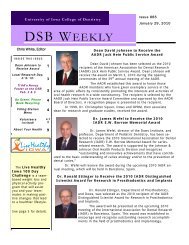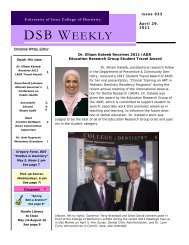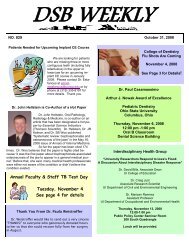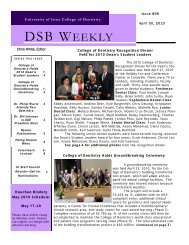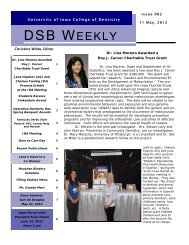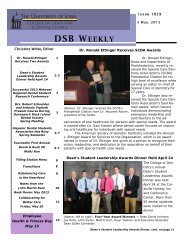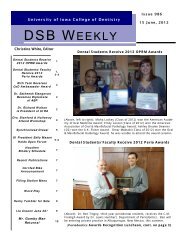Iowa Section of AADR - The University of Iowa College of Dentistry
Iowa Section of AADR - The University of Iowa College of Dentistry
Iowa Section of AADR - The University of Iowa College of Dentistry
You also want an ePaper? Increase the reach of your titles
YUMPU automatically turns print PDFs into web optimized ePapers that Google loves.
20. Growth Relationships between the Mandible and Standing Height by Occlusion<br />
D.G. Meier 1 , R.N. Staley 1 , C.M. Kummet 1<br />
1 <strong>University</strong> <strong>of</strong> <strong>Iowa</strong><br />
Objectives: To measure longitudinal growth <strong>of</strong> the mandible and standing height from 6-13 years in Class I normal<br />
occlusions (CINO) and Class II malocclusions (CIIM), and correlate the variables to describe the strength <strong>of</strong> the<br />
associations in the occlusion groups.<br />
Methods: Cephalograms <strong>of</strong> 30 male and 28 female participants in the <strong>Iowa</strong> Growth Study were used [IRB approval].<br />
Dial calipers were used to measure mandibular length between articulare-pogonion (Ar-Pg). Standing height<br />
measurements were obtained from the <strong>Iowa</strong> Growth Study. Spearman correlations were used to correlate growth <strong>of</strong><br />
standing height and articulare-pogonion in subjects with CINO (15 males and 15 females) and CIIM (15 males and<br />
Results:<br />
two occlusion groups occurred at age 9 in females (r=0.7235 [CINO]; r= -0.0070 [CIIM], p=0.0448). Growth curves<br />
for mandibular length and for standing height were similar but key differences occurred in growth acceleration in<br />
both genders in both occlusion groups.<br />
Conclusions: Correlations between growth in standing height and length <strong>of</strong> mandible in CINO and CIIM subjects<br />
were low to moderate positive. <strong>The</strong> correlations have minimal clinical application.<br />
Supported by: <strong>University</strong> <strong>of</strong> <strong>Iowa</strong>, <strong>College</strong> <strong>of</strong> <strong>Dentistry</strong>, Dows Research Award<br />
21. Changes in Fourth-Year Dental Students’ Presentation <strong>of</strong> Treatment Plans<br />
M. Popowski1 , M.R. McQuistan 1 , C.L. Straub-Morarend 1 , F. Qian1 1 <strong>University</strong> <strong>of</strong> <strong>Iowa</strong><br />
Objective: To assess whether dental students change their methods <strong>of</strong> presenting treatment plans to patients as<br />
they progress through the fourth year.<br />
Methods: A survey was developed and administered to all <strong>University</strong> <strong>of</strong> <strong>Iowa</strong> <strong>College</strong> <strong>of</strong> <strong>Dentistry</strong> fourth-year dental<br />
students at two points in time (N=77; July and October 2010). <strong>The</strong> survey assessed the duration and content <strong>of</strong><br />
students’ treatment plan presentations. Univariate analyses were performed. <strong>The</strong> nonparametric Wilcoxon signed<br />
the two time points. IRB approval was obtained prior to beginning the study.<br />
Results: 46 students completed the survey at two points in time for a matched response rate <strong>of</strong> 59.7%. On average,<br />
students spent 11-20 minutes presenting a treatment plan to a new patient, with 37% spending more time as<br />
the semester progressed. Students spent 1-10 minutes reviewing an accepted treatment plan with a returning<br />
patient, with 24% spending more time as the semester progressed. 47% <strong>of</strong> students frequently presented multiple<br />
treatment plans to a patient, but this decreased over time. During the initial presentation <strong>of</strong> the treatment plan,<br />
students were most likely to discuss cost <strong>of</strong> treatment (98%), number <strong>of</strong> visits to complete treatment (91%),<br />
etiology <strong>of</strong> treatment needs (80%), and maintenance (78%). Students were least likely to discuss evidence relevant<br />
to the planned treatment (13%), case prognosis (67%), and material selection (67%). With the exception <strong>of</strong> cost,<br />
the number <strong>of</strong> students who discussed the aforementioned aspects <strong>of</strong> the treatment decreased over time.<br />
Conclusion: As the semester progressed, students changed the amount <strong>of</strong> time they spent presenting treatment<br />
plans to patients and the content they presented to their patients.<br />
Supported by: <strong>University</strong> <strong>of</strong> <strong>Iowa</strong>, <strong>College</strong> <strong>of</strong> <strong>Dentistry</strong>, <strong>Iowa</strong> Dental Research Grant<br />
21 20



